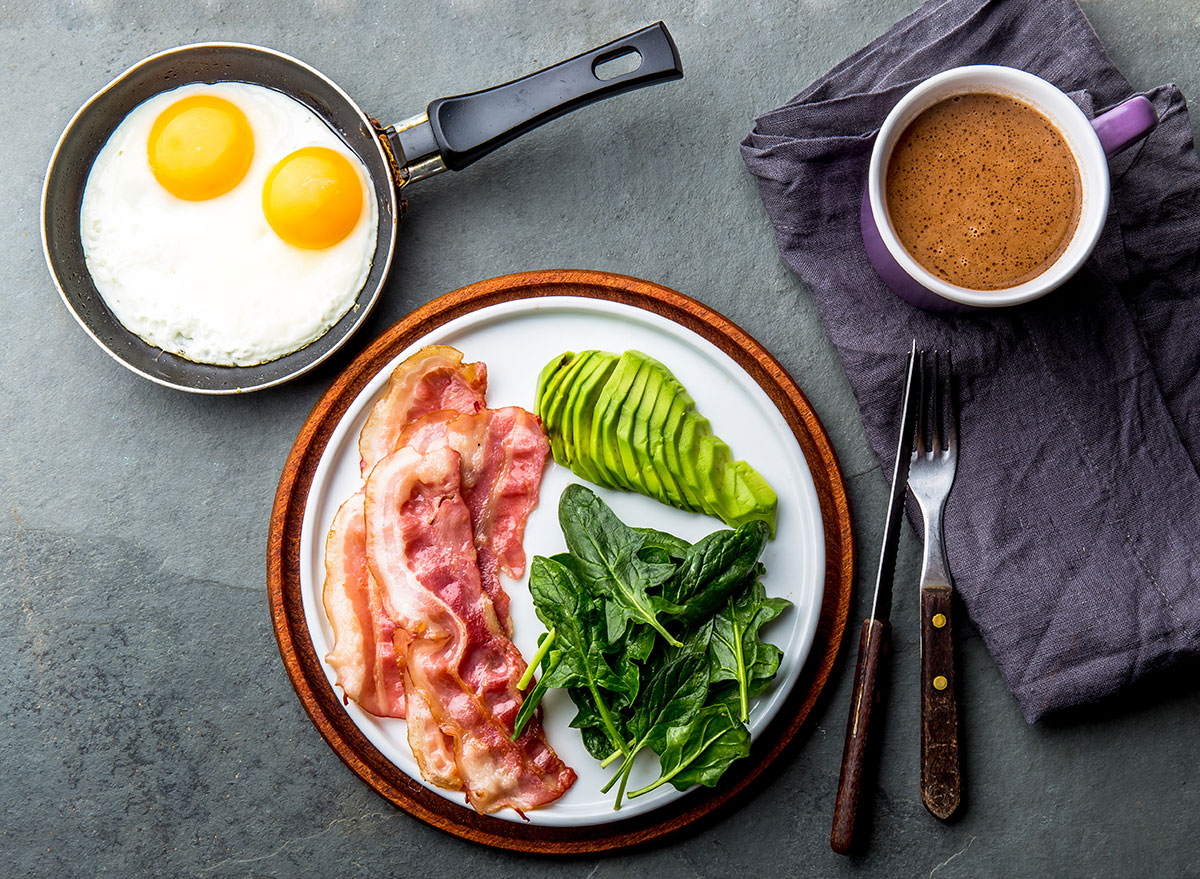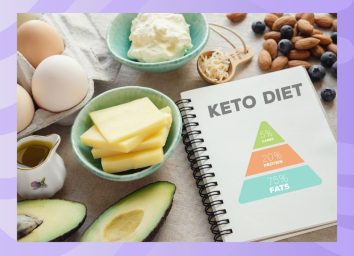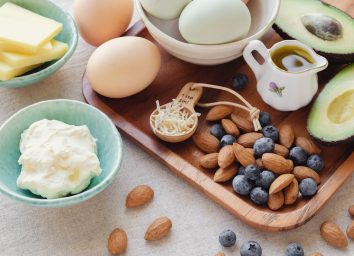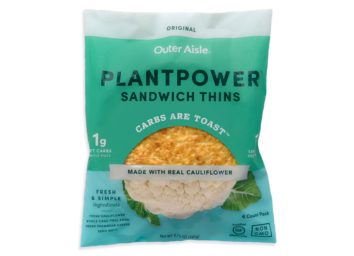Is the Keto Diet Safe? The Real Risks and Rewards of Going Ultra-Low Carb

The rise of the keto diet is hard to overlook. From keto cruises to keto-friendly product lines from food manufacturers, it seems like everyone knows someone who has embraced the keto lifestyle.
With such a boom in popularity, many dieters are turning to the internet and social media for keto inspiration. However, there can be conflicting and confusing information about what this diet actually entails, which leaves some people asking, “what actually is the keto diet—and is it safe?”
What is the keto diet?
For starters, the keto diet is more than just eating unlimited amounts of bacon, eggs, and cheese—despite what some Instagram accounts would have you believe. Keto, also known as the ketogenic diet, is a way of eating that allows the dieter to enter a state of ketosis. When you are in ketosis, your body is breaking down stored fat into molecules called ketones that are released into your bloodstream and flushed out in your urine. Ketosis occurs when your body shifts from burning sugar and carbohydrates to stored fat.
In order to get into this metabolic state, the diet consists of high-fat and very low-carb foods. Cedrina Calder, MD, a preventative medicine doctor based in Nashville, explains that most people in ketosis aim to stay under 20 to 50 grams of net carbs total for the day, though the specific carb tolerance varies from person to person based on a number of factors, including activity level. When calculating net carbs, take the total carb count and subtract out the quantity of fiber and sugar alcohols, as those do not have the same impact on blood sugar as other carbs.
For reference, one medium apple has more than 20 net carbs, which would top out the daily limit for many keto-ers, making ketosis difficult to maintain.
“This diet is very hard to sustain on a long-term basis for the average person,” said Dr. Calder. “For the average patient, I advise them to choose a healthy pattern of eating that they can sustain rather than focus on a temporary diet.”
Keto weight loss results can be striking and quick
With so many restrictions, it can seem surprising that keto has gained as much traction as it has. Like many recent phenomena, it all goes back to one cause: Social media.
The boom of Instagram, blogs, and other photo-sharing sites has led to more transformation pictures circulating than seemingly ever before. And the keto diet is a prime candidate for producing noticeable results quickly, making it a staple for the popular Instagram hashtag #TransformationTuesday.
“Recently, more and more people are inquiring about the keto diet—not necessarily for a long-term solution, but just to jumpstart their weight loss journey,” said Gabrielle Mancella, RD, who says that at least one-third of her daily patients inquire about going keto.
When you enter ketosis, the switch to burning stored fat creates a diuretic effect, making people lose water weight quickly compared to other methods of dieting. This can make progress look and feel quick at first.
How to get into ketosis
As you enter a state of ketosis, many people experience symptoms known as the “keto flu.” While not a real flu, the transition period can cause headaches, nausea, weakness, muscle cramps, difficulty concentrating, constipation, or diarrhea. These symptoms can be caused by dehydration, sugar withdrawals, or an imbalance of electrolytes—all common effects of switching to the ultra-low-carb diet.
For many people, the keto flu is enough to convince them to give up on this way of eating. But, if you stick it out, the flu symptoms typically subside in about a week. Dieters can avoid, or lessen the symptoms of, the keto flu by drinking enough water, seeking out electrolytes, and cutting back on their carb intake gradually.
Once in a sustained state of ketosis, many dieters report enhanced mental clarity and overall improved wellbeing, in addition to weight loss. However, there hasn’t been a great deal of research done yet to determine if these results are an inherent trait of the diet. Dr. Calder said more research is needed to understand the long-term effects of the keto diet.
To check if you are in ketosis, strips from the drug store can detect the presence of ketones in urine.
The downsides of going keto
While the weight loss can be quick, the keto diet also has some potentially serious drawbacks.
“Being in a state of ketosis can be dangerous for people with kidney disease or diabetes, especially type 1 diabetes,” Dr. Calder said. “I also would not recommend it for individuals with an unhealthy relationship with food. Restrictive diets can worsen this relationship.”
Because success on keto is dependent on cutting out foods that don’t fit into the ultra-low-carb diet, this is not a diet made for people who like frequent cheat days or little daily indulgences, Mancella explains. After eating enough carbs that your body exits ketosis, the whole process has to begin again to get back into the fat-burning state.
“This puts immense strain on the body, and, in turn, is contraindicative to weight loss goals,” Mancella says. “The brain’s main source of energy are carbohydrates, and when we limit this, we are in turn affecting all of our other body processes.”
Although she said that in healthy adults keto is generally safe because the body is able to self-regulate ketone levels by flushing the excess through urine, Mancella added that dieters should approach keto with caution.
“If not done right, this diet can cause havoc on our bodies,” she says. “As a society, we have turned to a culture of restriction and extremes in order to obtain unrealistic beauty and aesthetic standards without considering the long-term consequences.”
Knowing the restrictive nature, some people turn to the keto diet as a quick fix before an event that they want to drop a few pounds for quickly. Even that, however, can have some unintended consequences.
“Anyone starting a keto diet should be aware that once they stop the diet, they are likely to regain weight if they do not transition to a healthy diet,” Dr. Calder said.
What do you eat on a keto diet?
The keto diet itself doesn’t have any required meals. The only goal is to stay under your allotted net carbs each day, so there is a lot of variation in how people choose to go about following the diet.
Generally, commonly eaten keto diet foods include meat, eggs, full-fat dairy, and low-carb vegetables, which helps to up your fat intakes to help maintain satiety without overdoing it on the carbs. You should aim for 70 to 80 percent of your daily calories to come from fat, 20 to 25 percent to come from protein, and 5 to 10 percent from carbs in order to maintain ketosis.
“A diet high in unhealthy fats increases the risk of heart disease,” Dr. Calder says, explaining that if someone does choose to pursue the keto diet, they should opt to eat lean protein, low-fat dairy products, and healthy fats, including nuts, nut butters, seeds, avocado, and healthy oils.
Planning ahead can be the key for success on the keto diet to avoid falling into the trap of eating carbs out of convenience. While there are certainly plenty of options when eating out at restaurants, keeping it keto without a plan can be a recipe for disaster.
“I caution anyone who is new to concepts including portion control, meal prepping, grocery shopping, exercise, and, including, but not limited to, even cooking their own meals, as this diet will likely be detrimental to their long-term health,” Mancella said.
Is keto for you?
When it comes to weight loss, Dr. Calder explains that all diets have the same end goal: creating a calorie deficit.
“If your goal is weight loss, you do not need to be on a keto diet to achieve this,” said Dr. Calder. “You can create this deficit by making different changes to your diet and eating patterns, and with physical activity.” She suggests that the average person consider a balanced, heart-healthy diet consisting of lean protein, fruits, vegetables, healthy fats, and high-fiber, whole-grain carbohydrates.
There is no one-size-fits-all approach to dieting and healthy eating. Every body is different, and different people need to find the right dietary plan that fits their physical, emotional, and financial needs.
While the ultra-low-carb nature of keto might be able to help people shed some weight quickly, it is not a universal solution for everyone, and any new diet should be undertaken with guidance from a health care provider.








